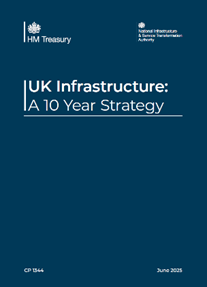T: 01822 851370 E: [email protected]
Visit RSN Survey about life in rural England to find out more.
Decade-Long Infrastructure Strategy Unveiled with £725bn Investment Plan
 The Government has published a new 10-Year Infrastructure Strategy, setting out a long-term plan for investment in economic and social infrastructure across the country. The strategy aims to provide greater stability and coordination in how infrastructure is planned, funded, and delivered.
The Government has published a new 10-Year Infrastructure Strategy, setting out a long-term plan for investment in economic and social infrastructure across the country. The strategy aims to provide greater stability and coordination in how infrastructure is planned, funded, and delivered.
Published on 19 June 2025, the strategy pledges at least £725 billion in public funding over the next decade, including a minimum of £9 billion annually for essential maintenance across the health, education, and justice estates. This is expected to rise to over £10 billion a year by 2034-35.
This whole-government approach integrates economic infrastructure (such as transport, energy, digital and water) with social and housing infrastructure — including schools, hospitals, and public service buildings. It also introduces new delivery mechanisms intended to provide certainty for investors and the construction sector, reduce project backlogs, and support local economic growth.
 Notable elements of the strategy include:
Notable elements of the strategy include:
- A new National Infrastructure and Service Transformation Authority (NISTA), which will oversee delivery and provide expert project assurance and spatial planning support.
- A shift toward preventative maintenance to reduce long-term costs and avoid disruptive service failures.
- A digital Infrastructure Pipeline, to be launched in July 2025, offering visibility of upcoming projects and enabling better planning for industry.
- Specific investment commitments to projects across all UK nations and regions — including transport upgrades, flood defences, housing delivery, and the decarbonisation of public buildings.
The strategy also aligns with the government’s forthcoming modern Industrial Strategy, aiming to unlock private investment, boost UK supply chains, and deliver wider social and economic benefits across communities.
While infrastructure is a reserved matter in some areas, the strategy acknowledges the devolved responsibilities of governments in Scotland, Wales and Northern Ireland, and outlines coordination plans where appropriate.
You can read the full UK Infrastructure: A 10-Year Strategy report here
The Rural Services Network will continue to monitor developments and advocate for the specific infrastructure needs of rural communities — particularly in ensuring investment reaches beyond urban centres to support resilient, connected and thriving rural places.



